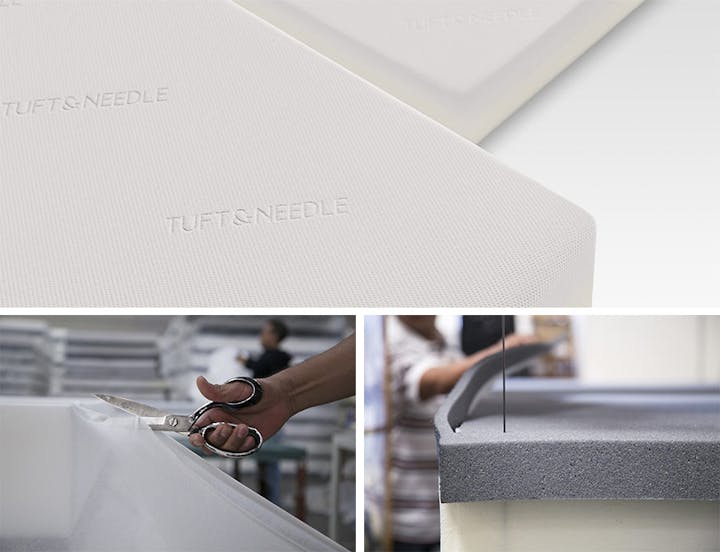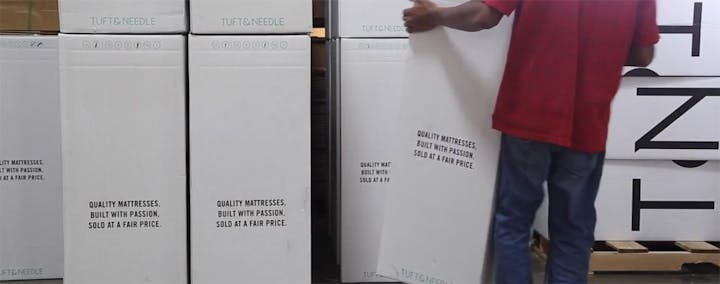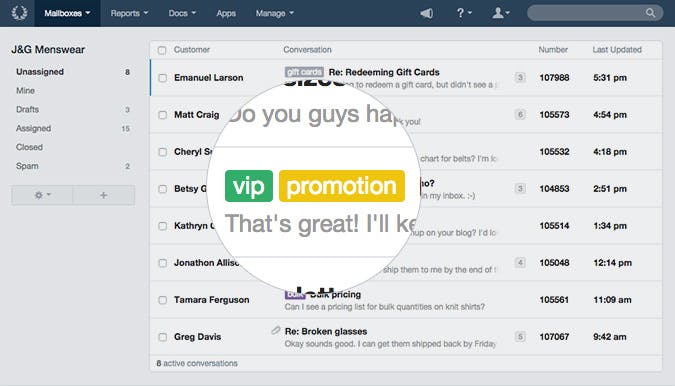Customer Story: Tuft and Needle
“When people talk about Tuft and Needle, we don’t want them to know necessarily that we have the best mattresses; we want them to remember us for being a company with amazing customer support."


![Icon: Industry]() IndustryEcommerce
IndustryEcommerce![Icon: Favorite Features]() Favorite FeaturesWorkflows
Favorite FeaturesWorkflows

Entering an industry that’s already populated with seemingly unbeatable titans often stems from personal frustration that evokes a vision to provide a better product.
We as consumers live in a time where those with entrepreneurial spirits who dream of better things are finding resources and tools that are capable of pushing these ideas forward, creating products that are far and above those we’ve settled for in the past.
John-Thomas Marino (JT), co-founder of Tuft and Needle, ran into a problem when he and his wife went shopping for a mattress. The mattresses he saw were overpriced, with pushy salesmen, endless options, and difficult return processes. He told the story to his college friend and co-founder, Daehee Park, and Park empathized. What they saw was an opportunity.
Together, they created a company and a built a team around shared values like self-awareness and craftsmanship, with an unflinching focus on the customer experience. Visit their site and you’ll see that transparency is a foundational value in how they speak to their customers regarding the materials they use, how they determine price, their 10-year warranty, easy returns/refunds, and more.
While a great product speaks for itself, we never really know a company until we hear how they speak to their customers.
I spoke with Evan Maridou, head of operations at Tuft and Needle, who wears multiples hats and is responsible for HR, hiring, data analytics, manufacturing supply chain, and his personal favorite, the customer experience.
“When people talk about Tuft and Needle, we don’t want them to know necessarily that we have the best mattresses; we want them to remember us for being a company with amazing customer support,” Evan said.
To understand this fantastic aspiration, we have to start at the beginning. Luckily for us, Evan has provided endlessly enriching insights into how Tuft and Needle accomplishes this.

Empathy, judgment, “maker” skills, and whole company support
“When we hire a customer experience team member, we hire for two really important things, which are empathy and judgment. . . . We are also interested in finding people who share a core company value, which is a desire to make and build things. It doesn’t matter what it is—for example my “Maker” skills are writing and photography,” Evan said.
These traits are important at Tuft and Needle because they believe they tie directly to an entrepreneurial nature and to creativity, which are fuel for their fire. Sometimes these unique Maker skills are utilized to bolster the customer experience.
Regardless if you’re an engineer or marketer, Tuft and Needle puts every new team member into customer support first. They slowly transition into their new roles but maintain a habit of doing support. In fact, there isn’t an individual support team that’s separate from the company: they truly exercise whole company support.

“Two reasons,” Evan said. “One, there’s no better way to have empathy for the customer, to know what they desire, and to understand what their pains are. Two, there’s no better way to learn about the company, the product, and our customers. If I hire a marketer out of school, he might want to play by the textbook. Instead, by doing support, he’s going to approach it from the angle of, ‘Okay, this is the number one question people ask us before they get the product.’”
This empathy goes beyond the customer and is a vital component for the onboarding experience. New hires are flown out to both facilities. At the factories, they watch the manufacturing process, see how the foam is poured, the way it’s cut, and how the mattresses are boxed.
“On our last trip, we were rolling out a new implementation of boxes, like different dimensions, and we were testing them out—everyone from the customer support team started building boxes with the factory workers, taping them closed and putting labels on. I want that to be a requirement, to have empathy for the factory workers who build the product, too. . . . You know, empathy goes both ways for the customer and the employee,” Evan told me.

This refined process for onboarding new hires and introducing them to the company culture is a surefire sign of great leadership. They are simply setting up new team members to be successful; they’re handing them a team jersey and saying, “Welcome.”
Artful tagging that leads to proactive iterations
Help Scout tags are used to categorize conversations, monitor trends, and trigger Workflows.

Tuft and Needle meticulously tags all their conversations and places them into specific categories. “We’ve got about 50 categories that range from, ‘I want to return my mattress,’ to ‘What kind of foam do you use,’ to ‘Problems with the website,’” Evan said. “We use the Help Scout API to combine all the data and use it as a contacts per order, like a KPI.”
They use this data to determine if it’s a product issue or a customer service issue. Whenever they see a defect in the product or website, they pull out the data and observe it with the whole team. If it’s a customer service issue, they learn from it.
“The engineer that made this integration was blown away by what the top three questions were. He volunteered to go and do customer support for two weeks and experience it firsthand, because he simply couldn’t believe that this is what customers were writing in. He used the queue to find a fix,” Evan said. “Now we’re trying to find a way to turn this into a rotation.”
It’s not that they don’t want customers writing to them; in fact, Tuft and Needle provides full-range support like email, phone, and live chat.
“If somebody writes an email because they couldn’t find the answer on the website or on their own, that’s a problem. We need to solve that, and for a couple of reasons,” Evan said. “One, it’s a really boring case for customer support through the phone. Passing along information that should be available on the website isn’t a rewarding experience for anyone. If somebody writes to us and we have a three-hour response time, that’s three hours the customers had to wait for something that should have been readily available.”
The use of this data isn’t to cut support costs but to refine and perfect the customer experience. As mentioned before, craftsmanship is a value of utmost importance, and small flaws like missing information is a pet peeve for those whose eyes are drawn to details.
How to complement judgment
I wrote about how Ritz-Carlton created a language playbook (or support lexicon) to unify its team. It’s a tool that aggregates the fundamentals of a company: the style, tone, language, values, goals, and processes.
When Evan told me that they, too, use a playbook, I knew there was more gold to be mined.
“The inspiration of the playbook comes from JT. Taken from the idea that you’re flying an airplane and something goes wrong, this playbook literally shows up and says, ‘Do these ten things right now,’” Evan said.
“We actually complement judgment with playbooks. If you don’t know what to do, just go to our internal company Wiki and there’s literally step-by-step instructions to execute anything in the company.”
The playbook, however, is not a replacement for learning through experience. It is something tangible and nearby that can help in times of confusion or self-doubt.
“For example, one of the rules that we have is you can’t ask a team member a question about support without first searching for the answer in our internal Wiki. If there isn’t an answer, drop the question in Slack, teammates answer it, vote on which one is accurate, and favorite it. We’re big on writing these playbooks and sharing the information in a meaningful way.”
Playbooks by nature are flexible and open for reinvention. As a company grows and processes scale and adapt, so will the playbook.

With an onboarding process that entails two weeks of mandatory support, the utilization of tags and data, and a playbook that acts as a guardian angel, it’s obvious that Tuft and Needle isn’t happy with great customer support—they want to be known for epic customer support.
Thank you to Evan, JT, and the team at Tuft and Needle for sharing this valuable insight into your process for building a remarkable team.
Try the customer support platform your team and customers will love
Teams using Help Scout are set up in minutes, twice as productive, and save up to 80% in annual support costs. Start a free trial to see what it can do for you.
Try for free
The Supportive Weekly: A newsletter for people who want to deliver exceptional customer service.





